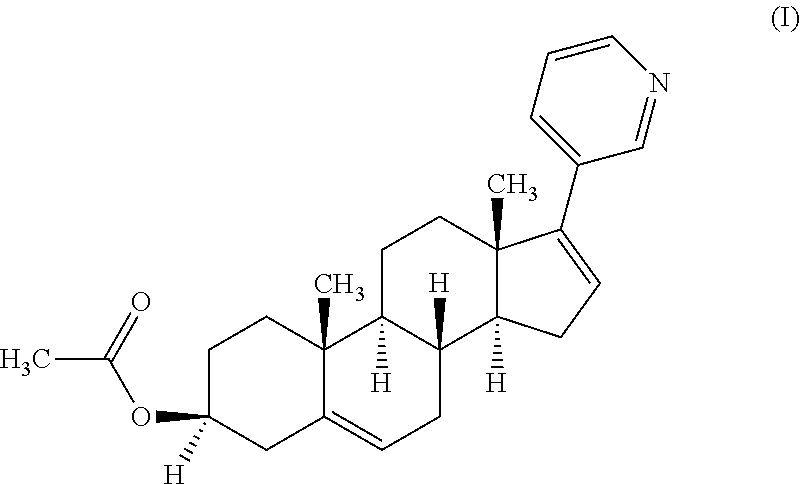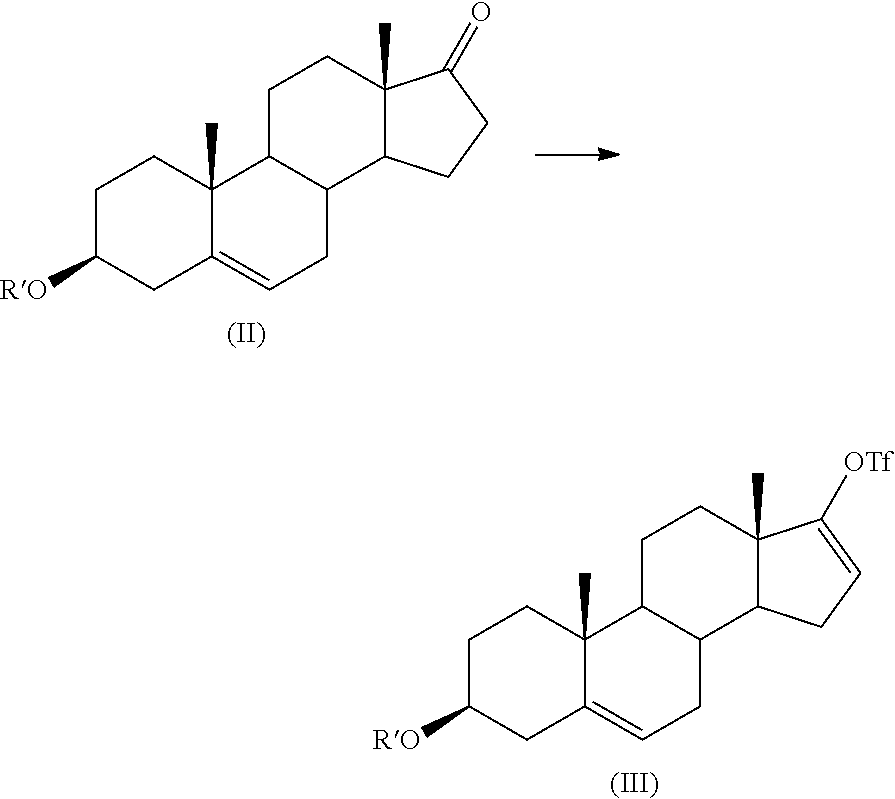Process for preparing 17-substituted steroids
a technology of substituted steroid and process, which is applied in the field of process for preparing 17 substituted steroid, can solve the problems of low overall yield of the process (around 48%), low estimated overall yield starting from dehydroepiandrosterone (around 41%), and achieves the effect of easy and efficien
- Summary
- Abstract
- Description
- Claims
- Application Information
AI Technical Summary
Benefits of technology
Problems solved by technology
Method used
Image
Examples
example 1
Synthesis of dehydroisoandrosterone-3-formate (DHEA formate)
[0088]A solution of 100 g (0.346 mole) of dehydroepisoandrosterone (DHEA) in 500 ml of formic acid 80-99% was maintained 4 hours at 20-25° C. and the end of the reaction was monitored by HPLC (area % of DHEA). The solution was then concentrated at 50° C. under vacuum (40 mbar). 500 ml of CH2Cl2 were added to the concentrate and 400 ml of saturated NaHCO3 were added to the solution. The mixture was stirred for 30 minutes at 20-25° C. The two layers were then separated. The organic layer was washed with 100 ml of water. The organic layer was dehydrated and used as it was on the triflating stage. The yield was assumed to be 100% from the DHEA
example 2
Synthesis of 3β-formyloxyandrosta-5,16-dien-17-yl-trifluoromethanesulphonate (triflate compound)
[0089]To a solution of 100 g of DHEA formate (0.316 mole) in 1 l of CH2Cl2 were added simultaneously a solution of 98 g (1.1 eq.) of trifluoromethanesulfonic anhydride in 500 ml of CH2Cl2 and a solution of 34 g (1 eq.) of 2,6-lutidine in 500 ml of CH2Cl2, over about 1 hour, at a temperature of 20±2° C. Lutidine was charged once about 15% of triflic anhydride solution had been added. The mixture was stirred for 1 hour at 20±2° C. The mixture was cooled to 10-15° C., and a solution of 53 g of NaHCO3 (2 eq.) in 1 l of water was added to the mixture at 10-15° C. over 15-30 minutes. The mixture was stirred for at least 1 hour at 20-25° C. Layers were then separated and the organic layer was washed with 0.2 l of water. The organic layer was concentrated at 35° C. under vacuum (40 mbar) to give 142 g of crude triflate compound which contained 100 g (by HPLC assay) of pure triflate compound (0.22...
example 3
Synthesis of Abiraterone
[0091]To a solution of 100 g (0.22 mole) of estimated pure triflate compound (by HPLC assay) in 1 l of THF were added 36 g (1.1 eq.) of diethyl (3-pyridyl)borane, and then 3 g (2 molar %) of bis(triphenylphosphine)palladium (II) chloride. A solution of 94 g (4 eq.) of Na2CO3 in 0.4 l of purified water was added to the mixture which was heated to reflux (65-67° C.) under efficient stirring (biphasic mixture) for a period of 30 minutes to 1 hour (IPC HPLC). The mixture was cooled to 15-20° C., and 1 l of toluene and then 1 l of water were added to the mixture which was stirred for a period of 10-15 minutes. The mixture was filtered through a bed of Clarcel® to remove the Pd catalyst and the two layers were separated. The aqueous layer was washed with 0.2 l of toluene. Organic layers were then washed with 0.1 l of water. The organic layer was concentrated at 35-40° C. under vacuum (20 mbar) to give the crude abiraterone formate which was hydrolysed in 380 ml of ...
PUM
 Login to View More
Login to View More Abstract
Description
Claims
Application Information
 Login to View More
Login to View More - R&D
- Intellectual Property
- Life Sciences
- Materials
- Tech Scout
- Unparalleled Data Quality
- Higher Quality Content
- 60% Fewer Hallucinations
Browse by: Latest US Patents, China's latest patents, Technical Efficacy Thesaurus, Application Domain, Technology Topic, Popular Technical Reports.
© 2025 PatSnap. All rights reserved.Legal|Privacy policy|Modern Slavery Act Transparency Statement|Sitemap|About US| Contact US: help@patsnap.com



